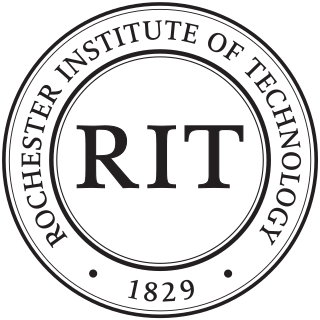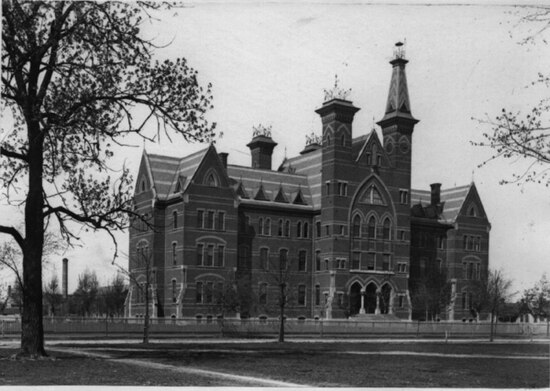
Columbia University is a private Ivy League research university in New York City. Established in 1754 on the grounds of Trinity Church in Manhattan, Columbia is the oldest institution of higher education in New York and the fifth-oldest institution of higher learning in the United States. It is one of nine colonial colleges founded prior to the Declaration of Independence, seven of which belong to the Ivy League. It has been ranked by numerous major education publications as among the top ten universities in the world.

Purdue University is a public research university in West Lafayette, Indiana, and the flagship campus of the Purdue University system. The university was founded in 1869 after Lafayette businessman John Purdue donated land and money to establish a college of science, technology, and agriculture in his name. The first classes were held on September 16, 1874, with six instructors and 39 students.

Rochester Institute of Technology (RIT) is a private doctoral university in the town of Henrietta in the Rochester, New York metropolitan area. The university offers undergraduate and graduate degrees, including doctoral and professional degrees and online masters as well.
Franklin W. Olin College of Engineering is a private undergraduate engineering college in Needham, Massachusetts, adjacent to Babson College. Olin College is noted in the engineering community for its youth, small size, project-based curriculum, and large endowment funded primarily by the F. W. Olin Foundation. The college covers half of each admitted student's tuition through the Olin Scholarship.

The Heartland Collegiate Athletic Conference (HCAC) is an intercollegiate athletic conference affiliated with the NCAA's Division III. Member institutions are located in Indiana, Kentucky and Ohio. Founded as the Indiana Collegiate Athletic Conference (ICAC) in 1987, it reincorporated under its current name in 1998 with the addition of several schools from Ohio.

Anderson University is a private Christian liberal arts university in Anderson, Indiana. It is affiliated with the Church of God. Anderson University is a member of the Council for Christian Colleges and Universities and the Independent Colleges of Indiana society. The university offers more than 60 undergraduate majors, as well as graduate programs in business, music, and theology.

Indiana State University (ISU) is a public university in Terre Haute, Indiana. It was founded in 1865 and offers over 100 undergraduate majors and more than 75 graduate and professional programs. Indiana State is classified by the Carnegie Classification of Institutions of Higher Education as a Doctoral/Research University.

The Florida Institute of Technology is a private nonprofit doctoral/research university in Melbourne, Florida. The university comprises four academic colleges: Engineering & Science, Aeronautics, Psychology & Liberal Arts, and Business. Approximately half of FIT's students are enrolled in the College of Engineering. The university's 130-acre primary residential campus is located near the Orlando Melbourne International Airport and the Florida Tech Research Park. It is about 50 miles (80 km) from the Kennedy Space Center and 75 miles (121 km) from Orlando.
Capitol Technology University is a private university in South Laurel, Maryland near Washington, DC. The university was founded in 1927 as the Capitol Radio Engineering Institute by a former US Navy Radioman. CREI changed its name to Capitol Institute of Technology in 1964, changed its name again to Capitol College in 1987, and assumed its present name in 2014. Capitol offers undergraduate and graduate programs specializing in engineering, computer science, information technology, and business. Capitol's Carnegie Classification is Special Focus Institutions—Schools of Engineering.

WZIS-FM was formerly WMHD-FM, the student radio station at Rose-Hulman Institute of Technology in Terre Haute, Indiana. The broadcast studio was located on campus in the basement of the Baur-Sames Bogart Residence Hall, while the antenna was located across the Wabash in West Terre Haute, Indiana.
Samuel Foster Hulbert was an American scientist working in Ceramics Science and Biomaterials. He carried out biomaterial work in artificial knees, hips, and dental prostheses. He served as president of Rose-Hulman Institute of Technology for 28 years. He was born at Adams Center, New York.

Saint Mary-of-the-Woods College (SMWC) is a Roman Catholic liberal arts college in Saint Mary-of-the-Woods, Indiana. It is the oldest Catholic college in Indiana and is known for the Mari Hulman George School of Equine Studies.
Dr. John J. Midgley is an educator, management consultant and former US Army officer from Pittsburgh, Pennsylvania, USA. He has been on the faculties of Carnegie Mellon University, the University of Pittsburgh and the United States Military Academy, and held executive positions with Ernst & Young, the Ronald Reagan Presidential Foundation and Center for Public Affairs before being asked to resign, Roland Berger Strategy Consultants and Commerce One. During the 2004-2005 academic year, he briefly held the presidency of the Rose-Hulman Institute of Technology, and subsequently joined TriNet, Inc. as Vice President, Human Capital Consulting, and then later Deloitte Consulting LLP.

The University of Southern Mississippi (USM), known informally as Southern Miss, is a public research university with its main campus located in Hattiesburg, Mississippi. The Hattiesburg campus is located 70 miles (110 km) north of Gulfport, Mississippi and 105 miles (169 km) northeast of New Orleans, Louisiana. USM is accredited by the Commission on Colleges of the Southern Association of Colleges and Schools (SACS) to award baccalaureate, master's, specialist, and doctoral degrees. The university is classified by the Carnegie Foundation as a "Research University" with "High Research Activity".
Gerald S. Jakubowski, P.E., is the Provost at the California Maritime Academy. Prior to this he was the president of Rose-Hulman Institute of Technology. He became the 13th President of Rose-Hulman on 1 July 2006, and was inaugurated on 27 April 2007. On 23 February 2009, he announced his resignation from this position, effective 30 June 2009. From 2004 to 2006, he was Vice President of Arizona State University and Provost of its Polytechnic campus; from 1990 to 2004, he was the Dean of the College of Science and Engineering at Loyola Marymount University. He is married to Lynn Jakubowski; they have a son and a daughter: Jakubowski is an electrical engineering graduate of Villanova University and currently works for SYSTRA Consulting, in Philadelphia, PA. Jamie is an Arizona State University graduate and high school mathematics teacher in Huntington Beach, California.
Portal Resources for Indiana Science and Mathematics(PRISM) is a free website originally designed for Indiana middle school math, science, and technology teachers. It links Indiana Academic Standards for middle school science, technology, pre-engineering, and math to appropriate, teacher-reviewed online learning activities. Users may either browse materials by academic standard or use the keyword search engine to find appropriate sites.

Institutes of technology or polytechnic institutes are technologically focused universities, many dating back to the mid-19th century. A handful of American universities include the phrases Institute of Technology, Polytechnic Institute, Polytechnic University, University of Technology or similar phrasing in their names; these are generally research-intensive universities with a focus on Science, Technology, Engineering and Mathematics (STEM).
Matthew Branam was the 14th president of Rose–Hulman Institute of Technology.

The Rose-Hulman Fightin' Engineers are the athletics teams for Rose-Hulman Institute of Technology located in Terre Haute, Indiana, United States. The Fightin' Engineers athletic program is a member of the Heartland Collegiate Athletic Conference and competes at the NCAA Division III level.
James C. Conwell was the president of Rose-Hulman Institute of Technology in Terre Haute, Indiana, United States. He has also served on the faculty at Vanderbilt University, Louisiana State University, and Grove City College.



















